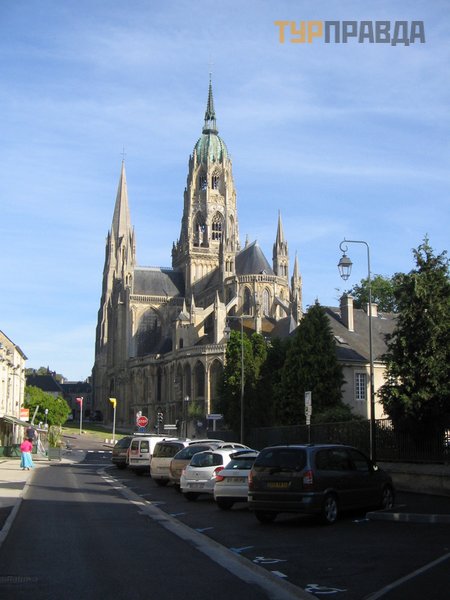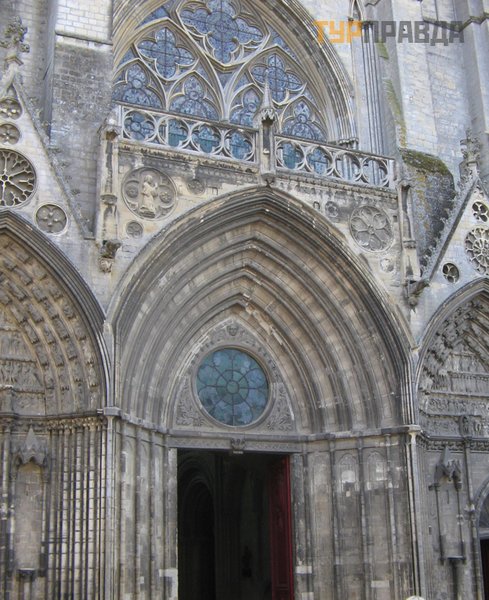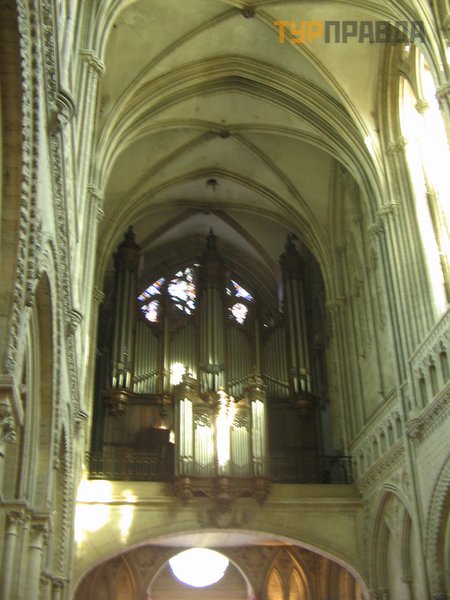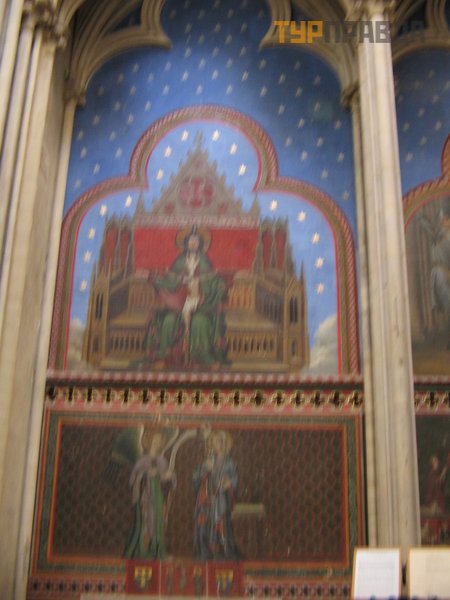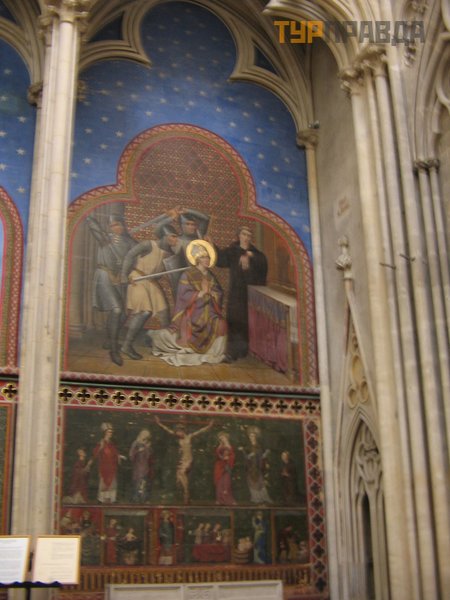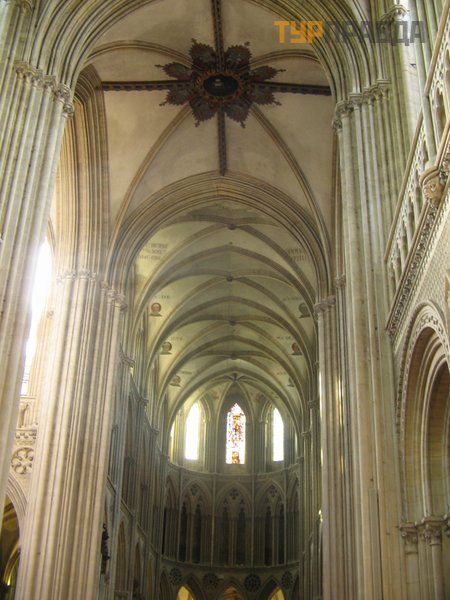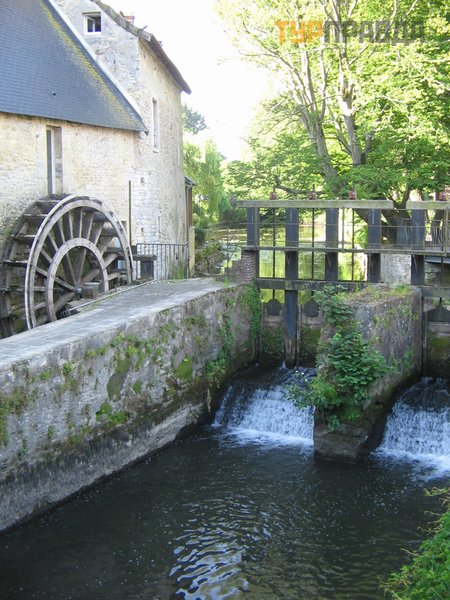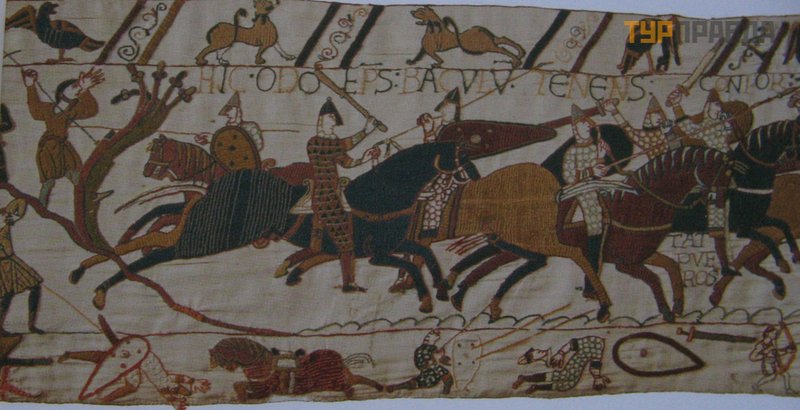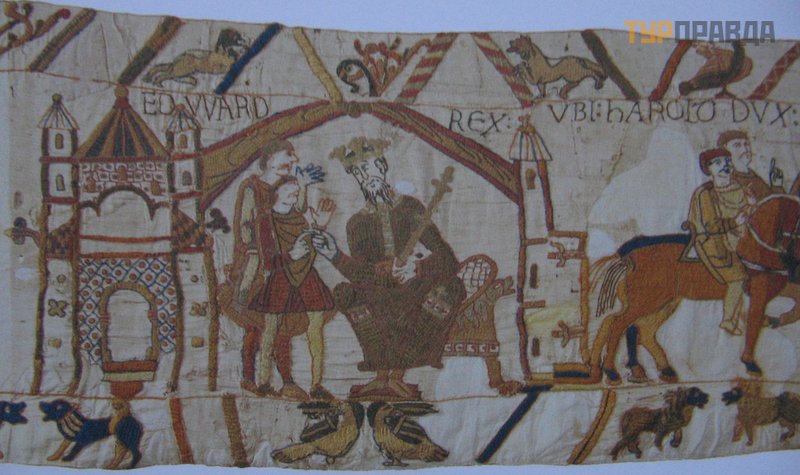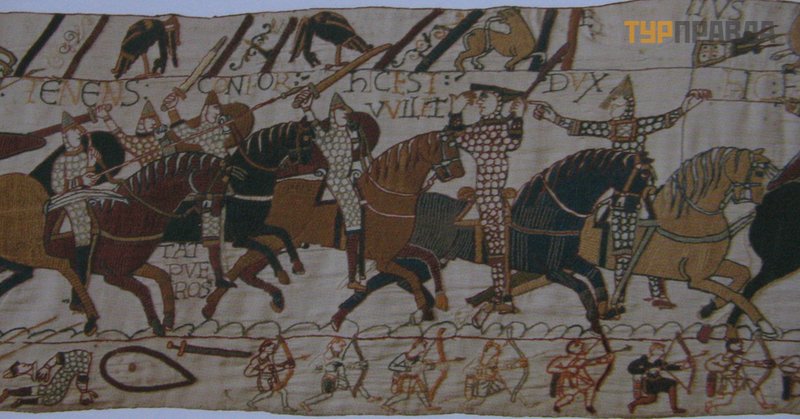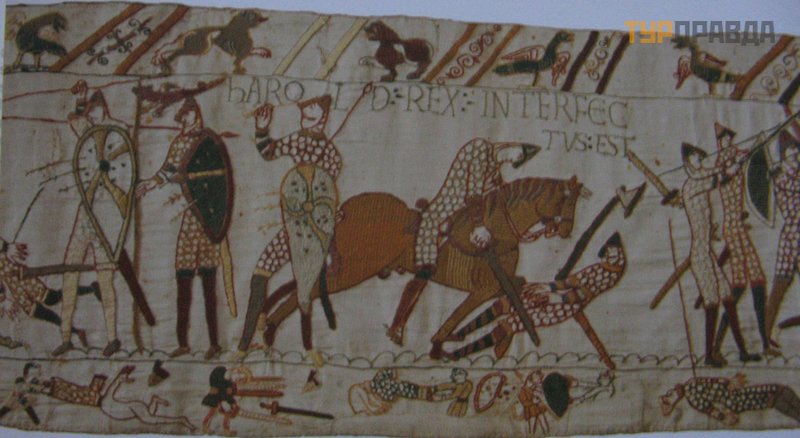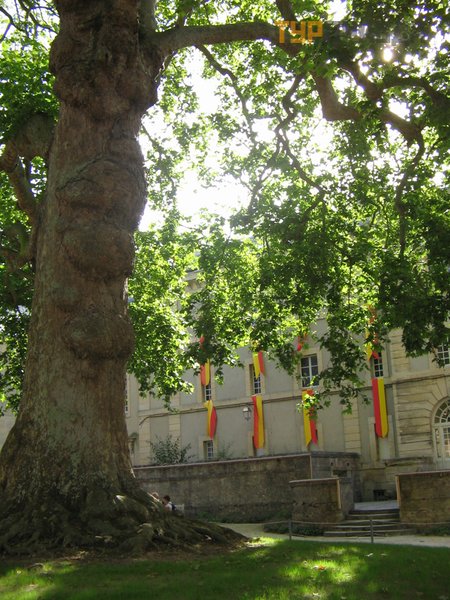Amazing carpet from Bayeux
In the morning we went to the place that I really wanted to see, but about which I knew almost nothing - the carpet museum, located in the small town of Bayeux.
A little history of the city. Bayeux appeared as a Roman camp to protect against attacks by the Germans in the 1st century BC. BC. under the name of Augustodurum. Although fortifications between the sea and the river Or existed before, no evidence of the existence of a Celtic city has been found. In the Gallo-Roman era, it was an important center on the road between the present day Lisieux and Valogne, at the ford over the Or, which crosses the city from south to north. Since the settlement was located on the territory of the Gallic tribe of the Bayokassians (as Pliny called them), in the 4th century. it is already referred to as Baiocassium.
At first, a settlement of artisans and merchants developed on the western bank of the river. Nearby was Mount Faunus, where even the Celtic Druids performed their ritual rites. This mountain was also associated with the first martyrs of the new religion - Christianity. All this, apparently, contributed to the further transformation of the settlement into a religious center. By the end of the Roman Empire, it becomes an episcopal center, one of the oldest.
The city of Roman times had a clear rectangular layout, which was also preserved in the medieval city, which for a long time did not go beyond the walls: artisans lived in the north, the nobility lived in the southwest, and church possessions were in the southeast. Moreover, church possessions are becoming more and more important and extensive, and the Norman castle that once existed disappears completely (the current De Gaulle Square).
The Bishopric of Bayeux is one of the oldest in Normandy. The first bishops came from the Gallo-Roman nobility, close to the kings. Episcopal power increased after the fall of the Roman Empire. After the formation in the X century. the duchy's bishops were from the Norman ducal family. Under William the Conqueror, religious power flourished in the city. Not far from Bayeux was Caen, which in the time of William was the main city of the duchy. The duke appoints Odon, his half-brother, as bishop. It was under him that the construction of the current cathedral began. And it is Odon who places the famous carpet in this cathedral for centuries.
During the war for the throne between the sons of Wilhelm, Bayeux suffered great destruction and decline. In the XIII century. he, as part of Normandy, passes under the authority of the French king. But the religious power of the clerics remains very strong in the city, because, possessing enormous wealth, they were able to buy benefits from the king. Only after the Hundred Years War did a strong secular power appear in the city, which resisted the religious one. Religious wars weakened the church, split the inhabitants and thus again slowed down the development of the city. Episcopal power increased in the 17th century, when the city went beyond the city walls, which ran approximately along the border of the still Roman camp. A number of monasteries of different orders appear around the center. The revolution put an end to religious power in the city.
Bayeux is located 12 km from the beaches where the Allies landed in June 1944. During Operation Overlord, the city was the first to be liberated, therefore it was not destroyed. Here settled the first French government in the liberated territory. To prepare for the operation to liberate Kan, the allies even built a bypass road (now the district boulevard) so that the vibration of heavy equipment would not destroy the ancient city and its cathedral. On the ring road there is currently a cemetery of the allies who died during the liberation of Normandy and a museum dedicated to this.
Since Bayeux has been an episcopal center for a long time, it is necessary to tell about the main cathedral of the city. The Cathedral of Our Lady of Bayeux was built from the 11th to the 15th century, it was the main cathedral of the bishopric that existed here from the 4th to the 19th century. Bishop Hugo of Evry began construction, but the cathedral was completed and consecrated under Odon. Odon participated in the conquest of England, received significant financial resources and after that was able to quickly complete the construction. The temple was consecrated in the presence of Wilhelm and Matilda. But this one has already been used, because on the carpet of Queen Matilda, Harold takes an oath of allegiance on the relics of this cathedral.
Cathedral of Our Lady of Bayeux
A quarter of the clergy was formed around the cathedral: the houses of clergy (XIV-XVIII centuries), the episcopal palace, the chapter library, the canon's house.
The oldest parts of the cathedral are the crypt (with decorative elements of the 11th century and murals of the 15th century) and the foundations of the towers of the western facade. Only the crypt was preserved after the war of succession of the sons of William the Conqueror, when the cathedral burned out almost completely. Then the cathedral burned again at the end of the 12th century. For almost a century and a half, the crypt was walled up. When they decided to rebuild the cathedral, the Romanesque style had already given way to the Gothic. Therefore, they began to rebuild it in a new style. So the cathedral was one of the first buildings of this style. It was perhaps the first example of the construction of a high central nave in architecture, which made it possible to better illuminate the temple.
Crypt of the Cathedral
From the outside, the cathedral is a building that can almost entirely be attributed to the 13th century. Romanesque towers were built on with Gothic lancet ends.
West portal of the cathedral from outside
The western faç ade has three portals. The sculptures were lost during the religious wars. The tympanum of the left portal is dedicated to the passions of Christ, the right - to the last judgment. During the Hundred Years War, the northern tower served as a sentinel.
West portal of the cathedral from the inside; 13th century stained glass
The most unusual is the southern facade. The tympanum of the canon's portal depicts scenes from the life of the English saint Thomas Becket. This saint was popular in France in the 13th century. Descriptions of his life were translated and read. He visited Bayeux during his exile from England. So scenes from his life ended up in a French cathedral. There is also a sculpture not broken by vandals, inscriptions on the wall dedicated to the deceased sister of one of the bishops.
The north portal didn't exist before. It was broken only in the 19th century. On this side, the chapter library adjoins the cathedral, where documents and books were copied and stored. From the same side, the reverse side of the towers of the western portal is clearly visible.
The high central tower, characteristic of Norman-style buildings, began to be built only in the 14th century. It was built for a long time, was destroyed by fires, changed by “restorations”, completed only in the 19th century already in the neo-Gothic style.
The interior of the cathedral has preserved several interesting places. The lower part of the cathedral is Romanesque. The decor contains elements of the Norman style. In the southern part, you can see on the bas-reliefs, including the so-called lovers from Bayeux, and a repetition of Harold's oath from the carpet. The first bishops are depicted in medallions on the ceiling of the choir.
Lovers of Bayeux
The Annunciation, the Trinity, the Crucifixion and scenes from the life of St. Nicholas - all of the 13th century, the martyrdom of St. Thomas Becket (19th century) are placed on the wall near the southern portal (canon).
The Trinity - above and the Annunciation - below (XIII century)
From the life of St. Nicholas (XIII century) - below, The murder of Thomas Becket (XIX century) - above
At the northern wall there is a treasury (entrance only with a group), where a carpet was kept for centuries, and now there are objects of the 12th-13th centuries (the riza of St. Regnobert, a casket of Arabic work, a cupboard with medieval paintings). Next to the entrance is a stained-glass window of the 13th century (another one is on the western portal, where the organ is). Behind the north tower is a passage to the chapter hall (only with a group), where the labyrinth has been preserved. The chapels of this side are connected with the library, the episcopal palace.
If you leave the cathedral through the western portal, turn left and walk along the street along the southern facade and further, cross the Or, then you will exit to the William the Conqueror Center located in the former seminary. The Bayeux Tapestry or the Queen Mathilde carpet is located there today. Throughout the city there are signs to the Carpet Museum. The museum occupies 2 floors. The upper one is the history of the creation of the carpet, and below, in the semi-darkness, under the glass is this miracle, which is described below. Audio guides in 14 languages are given at the entrance, incl. in Russian. The tour along the carpet takes approximately 1 hour. The maximum cost of a visit now is 9 euros, students and schoolchildren over 10 years old - 4 euros.
Some call this object a "carpet", some call it a "tapestry", but it's actually an embroidery. Some details do not fit in my head: how did this tapestry carpet manage to be preserved for almost 1000 years, how many people embroidered it (and its length is amazing), why this miracle was included in the UNESCO World Heritage List only in 2007?
The carpet (we'll call it that because it's called tapisserie) was embroidered right after the Battle of Hastings. There are two alleged customers (because at all times such work was carried out by order): Duchess-Queen Matilda, wife of William the Conqueror, and Bishop Odon, his half-brother. The second version seems to many to be more realistic for many reasons. Bishop Odon himself was a participant in the Battle of Hastings. After the conquest he took possession of the lands in Kent, and the style of embroidery, which has long been studied, is the south-eastern Anglo-Saxon. The carpet depicts three approximate bishops. He stood for a long time at the head of the bishopric of Bayeux (from 1049 to 1097), on his orders they began to build the Cathedral of Our Lady. The carpet depicts an oath scene on relics from the cathedral in Bayeux. The carpet was kept for many centuries in the Cathedral of Our Lady of this town, from where it was taken out “for public viewing” once a year in July on the occasion of the feast of relics (i. e. it was a story in pictures about the conquest of England by William for illiterate parishioners).
Bishop Odon takes part in the Battle of Hastings
Now I will state the figures related to embroidery. The carpet is embroidered on linen, threads of 8 colors are used. Width - about 50 cm, length - about 70 m. The carpet includes 58 scenes. It is believed that for almost 1000 years 2 scenes have been lost (perhaps, William's entry into London, his coronation in Westminster, the construction of the Tower). The carpet depicts in detail the events that took place from 1064 to 1066. More than 600 people, 200 horses, 50 dogs, 30 buildings, 40 ships were embroidered, the total number of subjects is more than 1500. After studying the embroidery, we came to the conclusion that the carpet was made by two (! ) embroiderers in 2 years. Above, the embroidered events are summarized in Latin. The embroidery shows tools, hairstyles, clothes of the 11th century, real events (the appearance of Halley's comet), mythological creatures from the stories known at that time (fables, ancient myths). Contemporaries (Guillaume from Poitiers and Guillaume from Jumiè ges) told about the historical events depicted on the carpet, a century later they were supplemented by two more authors, i. e. embroidery is documented.
Halley's Comet was seen during Harold's coronation
Whoever and wherever the carpet was embroidered, it was made in order to prove the legitimacy of William's conquest of England. It is a story about the triumph of good over evil, because Harold first swore allegiance to William as his overlord, and then broke it, for which he was punished, dying during the Battle of Hastings.
A few words about the characters on the carpet and the events that took place before those embroidered on it. I talked about Wilhelm in the previous part. Edward the Confessor was the son of one of the Norman duchesses (his mother Emma was the sister of William's grandfather). After the murder of her first Anglo-Saxon husband, she married his murderer, the Dane Knut. After that, Edward hid for many years with relatives in Normandy. Harold was the brother-in-law of the English King Edward the Confessor (he was married to his sister), a descendant of a wealthy Anglo-Saxon family in Wessex. Thus, William was the heir to the blood of the English king. Harold was supported by the Anglo-Saxon nobility, who elected him king after Edward's death.
Eduard the Confessor
The story begins in 1064, when Harold goes to William to convey the desire of Edward the Confessor to make him heir to the English throne. There is a version that he went to Normandy to ransom his brother, who was taken hostage. During a storm, he does not go where he planned. He is taken prisoner. Wilhelm ransoms Harold from captivity. He lives in Normandy, participates in William's campaigns in Brittany. Then follows the scene of the vassal oath on the relics of the cathedral in Bayeux.
Harold takes an oath on the relics of Notre Dame Cathedral
Harold then returns to England. Two years later, the childless Edward dies. Harold is crowned. Wilhelm becomes aware of the events in England. He equips the fleet, sails to England to receive his inheritance. Since in those days perjury was a serious sin, it is supported by the Pope, many European mercenaries join the army.
During the Battle of Hastings, Wilhelm was thought to have been killed. He opens his visor to show he's alive
Following is the story of the Battle of Hastings when Harold is killed. For a long time it was believed that he died from an arrow in his right eye. But there is a version that his brother died from an arrow, and Harold was killed with a sword. All this, as in a comic book, is told on the carpet. And this comic can be viewed endlessly - it does not bother.
Harold killed by an arrow
The first written mention of the carpet dates back to the 15th century. During the religious wars it was hidden. Scientists became interested in the carpet only in the 17th century. Until the 18th century, it was kept in the treasury of the Cathedral of Our Lady in Bayeux. During the revolution, when the churches were closed, the carpet was almost cut into pieces to pack the exported valuables. Fortunately, Lambert-Leforestier's lawyer intervened. Then Napoleon took the carpet to Paris, where it became a means of promoting his idea of a second conquest of the British Isles. The carpet was then exhibited to the public in the Louvre. When the conquest failed, the carpet was returned. In the 19th century they make a copy of it for England. During the Second World War, the carpet is in one of the castles, where it is studied by German scientists. Then he is transported to the Louvre to an exhibition of primitive art, from where they are supposed to be taken to Germany, but they do not have time. The carpet returns to Bayeux in 1945, where it remains today.
In the city, you can also see the art museum of Baron Gerard (in the part of the former episcopal palace, the rest is occupied by the city hall); next to the square Liberty Tree grows Liberty, planted during the revolution; a British military cemetery, a museum-memorial of the Battle of Normandy and a memorial dedicated to the journalists who died since 1944 (on the district boulevard). The oldest churches are dedicated to the first bishops: St. Exupery (in the east of the city, bishops were buried here), St. Vigor, St. Patrick. Half-timbered houses of the 14th-16th centuries and mansions of the 17th-19th centuries have been preserved in the city.
Freedom Tree
In Bayeux, the art of bobbin lace-making and porcelain production were developed.
Every year on the first weekend in July, the town hosts a medieval festival.
